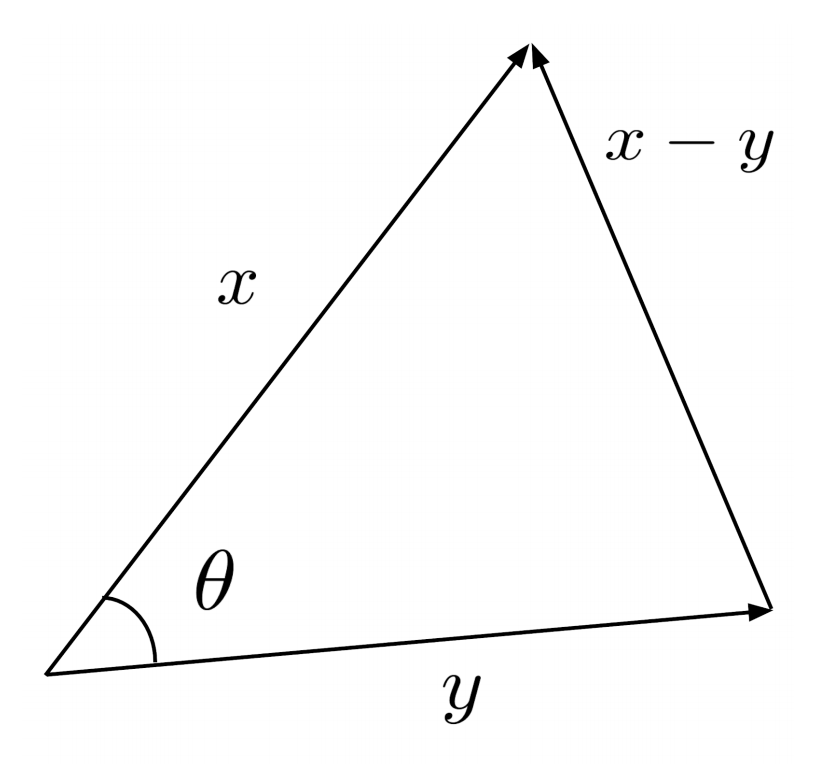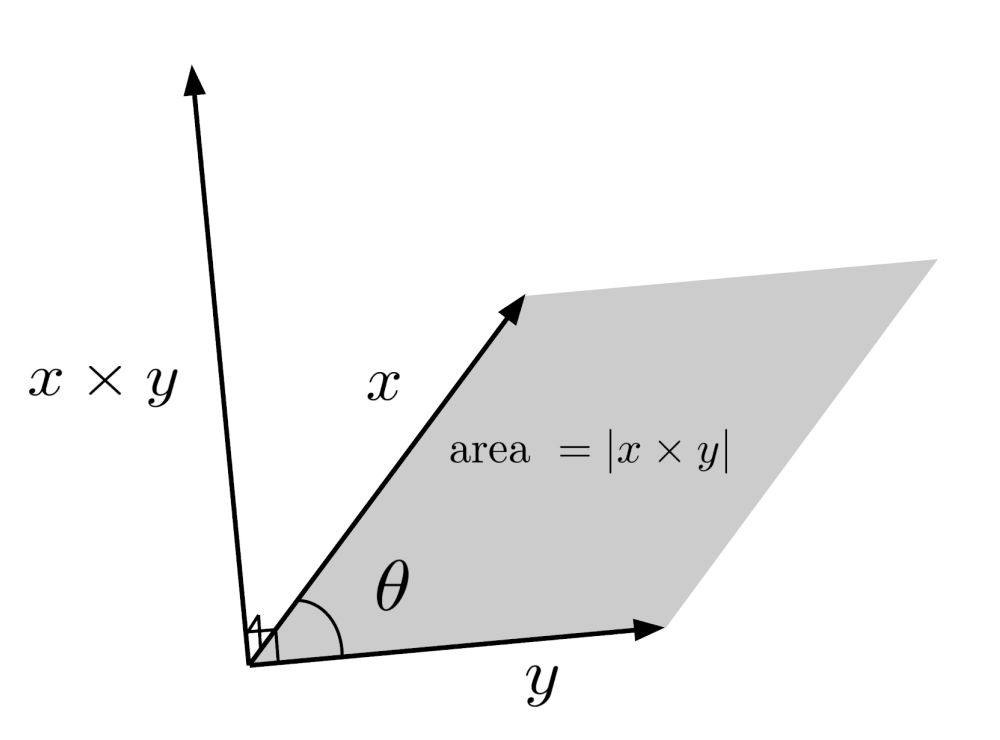Dot Product and Cross Product
What does it mean to multiply a vector by another vector?
This post is part of the book Justin Math: Linear Algebra. Suggested citation: Skycak, J. (2019). Dot Product and Cross Product. In Justin Math: Linear Algebra. https://justinmath.com/dot-product-and-cross-product/
Want to get notified about new posts? Join the mailing list and follow on X/Twitter.
We know how to multiply a vector by a scalar, but what does it mean to multiply a vector by another vector?
The two most common interpretations of vector multiplication are the dot product, and for vectors in 3 dimensions, the cross product.
Dot Product
The dot product is computed as the sum of products of components.
First of all, notice that the dot product of a vector with itself is just the vector’s norm, squared.
Also notice that the dot product can distribute over sums of vectors, just like multiplication.
One can also verify that the dot product behaves like multiplication in other ways – for example for two vectors $x=\left< x_1, x_2, \ldots, x_n \right>$ and $y=\left< y_1, y_2, \ldots, y_n \right>$ and any scalar $c$ we have $(cx) \cdot y = x \cdot (cy) = c(x \cdot y)$ and $x \cdot y = y \cdot x$.
Geometric Interpretation of Dot Product
Using the law of cosines on a triangle whose sides are formed by the vectors $x$, $y$, and $x-y$, we can find a geometric interpretation of the dot product:
where $\theta$ is the angle between the two vectors $x$ and $y$.

One interesting consequence of this formula is that perpendicular vectors have a dot product of zero: the angle between perpendicular vectors $\frac{\pi}{2}$ is $|x| |y| \cos \frac{\pi}{2} = |x| |y| (0) = 0$.
Even if the dot product is not zero, we can still use it to compute the angle between the two vectors.
Cross Product
For 3-dimensional vectors, we also have another interpretation of vector multiplication called the cross product. The cross product is given by
Using the above definition, one can verify that the cross product distributes over sums and satisfies $(cx) \times y = x \times (cy) = c(x \times y)$ for any scalar $c$.
However, when the two vectors in a cross product are interchanged, the result changes sign: $x \times y = -y \times x$. This is a key difference between the cross product and the dot product.
Geometric Interpretation of Cross Product
Like the dot product, the cross product also has a geometric interpretation:
This is similar to the geometric interpretation of the dot product, except we have $\sin \theta$ instead of $\cos \theta$, and we are talking about the norm of the vector resulting from the cross product.
As a result, the cross product $x \times y$ represents a vector whose norm is equal to the area enclosed by the parallelogram that has $x$ and $y$ as sides. Moreover, the cross product produces a vector that is perpendicular to the vectors $x$ and $y$.

To see that the cross product $x \times y$ is perpendicular to $x$ and $y$, observe that the dot products $(x \times y) \cdot x$ and $(x \times y) \cdot y$ both evaluate to $0$.
To understand why $| x \times y | = |x| |y| \sin \theta$, we can begin by squaring both sides of the equation and expressing the right-hand side using the dot product.
Now, we expand out the right hand side using $x = \left< x_1, x_2, x_3 \right>$ and $y = \left< y_1, y_2, y_3 \right>$. We find that some terms cancel, and the remaining terms can be rearranged into the square of the norm of the cross product.
Exercises
Evaluate the following vector expressions. (You can view the solution by clicking on the problem.)
$1) \hspace{.5cm} \left< 1,2,4 \right> \cdot \left< -1,-2,3 \right>$
Solution:
$ 7 $
$2) \hspace{.5cm} \left< 2,-2,3,3 \right> \cdot \left< -1,1,1,-1 \right> $
Solution:
$ -4 $
$3) \hspace{.5cm} 2 \left< 2,3 \right> \cdot \frac{1}{2} \left< 3,-2 \right> $
Solution:
$ 0 $
$4) \hspace{.5cm} \frac{1}{2} \left< 1,4,-2 \right> \cdot ( \left< 3,3,1 \right> - \left< 1,3,3 \right> ) $
Solution:
$ 3 $
$5) \hspace{.5cm} \left< -2,1,0 \right> \times \left< -2,3,0 \right> $
Solution:
$ \left< 0,0,-4 \right> $
$6) \hspace{.5cm} \left< 3,1,5 \right> \times \left< 2,-2,-1 \right> $
Solution:
$ \left< 9,13,-8 \right> $
$7) \hspace{.5cm} \left< 1,1,2 \right> \times (\left< 2,4,6 \right> - \left< 1,4,7 \right>) $
Solution:
$ \left< -1,3,-1 \right> $
$8) \hspace{.5cm} \frac{1}{3} \left< 1,0,2 \right> \times \left< 1,1,1 \right> \times \left< 0,0,3 \right> $
Solution:
$ \left< 1,2,0 \right> $
Solve for $x$. (You can view the solution by clicking on the problem.)
$9) \hspace{.5cm} \left< x,1,2 \right> \cdot \left< 1,2,x \right> = -4 $
Solution:
$x= -2 $
$10) \hspace{.5cm} \left< x,1 \right> \cdot (\left< 1,1 \right> - \left< 1,x \right> )=1 $
Solution:
$x= 0 $
$11) \hspace{.5cm} \left< x,-1,0,1 \right> \cdot \left< x,0,5,7 \right> = 16 $
Solution:
$x= \pm 3 $
$12) \hspace{.5cm} \left< 1,2,3 \right> \times \left< 1,x,3 \right> = \left< -6,0,2 \right> $
Solution:
$x= 4 $
$13) \hspace{.5cm} \left< 1,1,1 \right> \times (\left< 2,1,-2 \right> + \left< x,1,1 \right> ) = \left< -3,2,1 \right> $
Solution:
$x= -1 $
$14) \hspace{.5cm} \frac{1}{2} \left< 3,1,-2 \right> \times (\left< 0,x,0 \right> - \left< 1,0,2 \right> ) = \left< 2,4,5 \right> $
Solution:
$x= 3 $
Use the dot product to find the angle $\theta$ between the two vectors. (You can view the solution by clicking on the problem.)
$\begin{align*} 15) \hspace{.5cm} &\left< 1,1 \right> \\ & \left< 1,2 \right> \end{align*}$
Solution:
$\begin{align*} &\arccos \left( \frac{3}{ \sqrt{10} } \\ &\approx 18.43^\circ \end{align*}$
$\begin{align*} 16) \hspace{.5cm} &\left< -2,3,1\right> \\ & \left< 0,1,-1 \right> \end{align*}$
Solution:
$\begin{align*} &\arccos \left( \frac{1}{ \sqrt{7} } \\ &\approx 67.79^\circ \end{align*}$
$\begin{align*} 17) \hspace{.5cm} &\left< 2,0,3,-1 \right> \\ & \left< 1,1,0,2 \right> \end{align*}$
Solution:
$\frac{\pi}{2} = 90^\circ$
$\begin{align*} 18) \hspace{.5cm} &\left< 2,0,-1,0,2 \right> \\ & \left< -1,2,3,0,0 \right> \end{align*}$
Solution:
$\begin{align*} &\arccos \left(- \frac{5}{ 3\sqrt{14} } \\ &\approx 116.45^\circ \end{align*}$
Use the cross product to find the area contained by each parallelogram whose sides are given as vectors.
$\begin{align*} 19) \hspace{.5cm} &\left< 2,-1,0 \right> \\ & \left< 4,1,0 \right> \end{align*}$
Solution:
$ 6 $
$\begin{align*} 20) \hspace{.5cm} &\left< 1,2,3 \right> \\ & \left< 3,2,1 \right> \end{align*}$
Solution:
$ 4\sqrt{6} $
$\begin{align*} 21) \hspace{.5cm} &\left< 1,0,1 \right> \\ & \left< 1,1,1 \right> \end{align*}$
Solution:
$ \sqrt{2} $
$\begin{align*} 22) \hspace{.5cm} &\left< 3,-3,1 \right> \\ & \left< -4,1,-2 \right> \end{align*}$
Solution:
$ \sqrt{110} $
This post is part of the book Justin Math: Linear Algebra. Suggested citation: Skycak, J. (2019). Dot Product and Cross Product. In Justin Math: Linear Algebra. https://justinmath.com/dot-product-and-cross-product/
Want to get notified about new posts? Join the mailing list and follow on X/Twitter.